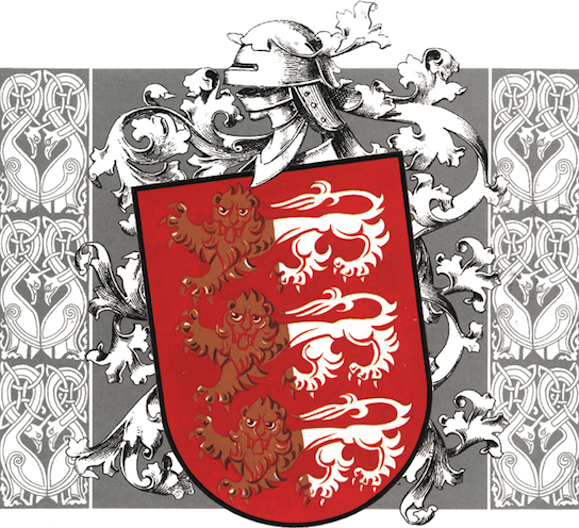The O’Briens are an illustrious and prominent clan that has shaped the history of Ireland. The name, also spelt O’Bryan or O’Brian, means “of Brian” indicating descendance from Brian Borumha mac Cennetig, or Brian Boru, the celebrated High King of Ireland. (The O’Briens also claim the mythological King Oilill Ollum to be their ancestor through the Dal gCais).
Brian Boru (925-1014) received the throne of Thomond (an area which covers much of modern day County Clare as well as parts of Limerick and Tipperary) after his elder brother, Mathgamain, was killed in 976. By 1002, he had attained the title of High King of Ireland, subjugating all the other kings in Ireland under his rule.
The King of Leinster Máelmorda mac Murchada, aided by the Dublin Vikings, rebelled against Brian’s rule. The two armies met on the field of Clontarf (now a suburb of Dublin) in 1014. Brian Boru’s army won the day but at the cost of Boru’s own life.
During the Tudor conquest of Ireland, the hereditary titles Earl of Thomond, Viscount of Clare, and Earl and Baron of Inchiquin, were contracted for the O’Briens to garner their support for the English crown. However, many of the clan supported Ireland’s independence from British rule.
Daniel O’Brien, the third Viscount of Clare, was one of the founders of the famed Irish Brigade within the Army of France. This brigade took part in nearly all major French land combat from 1690-1790. The regiment came to be known as Clare’s Dragoons. The fifth Viscount of Clare gave his life in service to the regiment, and the sixth Viscount led the brigade during the French victory at the Battle of Fontenoy. The brigade was immortalized not only through their actions but also by the writer Thomas Davies in his poem “The Battle Eve of the Irish Brigade.”
The O’Briens played important roles not only in the battles of Europe but also in America. A resounding 231 O’Briens took part in the American War for Independence. Jeremiah O’Brien helped orchestrate the capture of the British ships the Union and the Margaritta during the first naval engagement of the Revolution. George Morgan O’Brien was Union Brevet Brigadier General and acted as a model of bravery for the O’Briens during the American Civil War. Another heroic O’Brien was Fitzjames O’Brien. He was an emigrant to the United States and author for Harpers and Atlantic Monthly, who lost his life while serving in the New York National Guard during the Civil War. A more recent O’Brien patriot, George H. O’Brien Jr,. earned the Congressional Medal of Honor for his actions and bravery during the Korean War.
In Ireland, William Smith O’Brien (MP) carried the fighting spirit of the O’Briens by leading the Young Ireland Movement. He was to be hanged, drawn and quartered because of his leadership in a bloodless peasant insurrection that distastefully became known as “The Battle for Widow McCormack’s Cabbage Patch.” His sentence, however, was commuted, and he was transported to Australia. O’Brien was eventually pardoned after attempted escapes and five years in prison. A statue of him now stands on Dublin’s O’Connell Street. His daughter, Charlotte O’Brien, was an activist against the unfit conditions aboard emigration ships. And because of her efforts the Board of Trade eventually imposed stricter constraints on such ships.
The O’Briens are well known in many fields of the arts and entertainment. In the literary world, the O’Briens have produced such talent as Edna O’Brien who had great early success in the 1960s with her trilogy, The Country Girls, Lonely Girl, and Girls in Their Married Bliss despite the fact that they were banned throughout Ireland. O’Brien, the author of 20 books, has since received numerous awards, and is the subject of this issue’s cover story. Tim O’Brien is another O’Brien literary luminary who has written Tomcat in Love and The Things They Carried, a fictionalized account of his time in Vietnam.
O’Briens have been in the film industry since its inception. Eugene O’Brien was an early pioneer in the silent age of film and received a star on the celebrated Hollywood Walk of Fame. George O’Brien was a rugged cowboy in both silent and talkie films of the 1930s. Pat O’Brien “Hollywood’s Irishman in residence,” played good-guy Irish priests and cops in many Warner Bros. crime dramas of the 30’s and 40’s, as well as Knute Rockne – All-American in 1939. Edmond O’Brien won a best supporting Oscar playing a sweaty press agent in 1954’s The Barefoot Contessa. Virginia O’Brien was MGM’s deadpan singing comedienne in the 40s and 50s. Seven-year-old Margaret O’Brien almost stole Meet Me in St. Louis from Judly Garland. Richard O’Brien was the writer and an actor in the cult classic The Rocky Horror Picture Show and a presenter on the UK’s game show The Crystal Maze.
Today, the O’Briens can watch a few of their own on some of the best-liked shows on television. Maria de la Soledad Teresa O’Brien anchors on CNN’s American Morning along with her co-anchor, coincidentally with the same last name, Miles O’Brien. And for those O’Briens who stay up late, there is Conan O’Brien. Conan’s talk/variety show, Late Night with Conan O’Brien, has been attracting audiences for over nine years and has won the Writers Guild Award multiple times. Conan is scheduled to take over from Jay Leno as host of The Tonight Show in 2009.
The O’Brien name has become so famous it has been used on everything from battleships to booze. Brian Boru Vodka is a popular drink in Ireland. The O’Briens have also lent their name to the fictional character Miles O’Brien of Star Trek: The Next Generation and George Orwell’s “O’Brien” of 1984.
If the O’Briens’ long and celebrated past is any indication, they certainly will remain a talented clan for many years to come. ♦


Leave a Reply